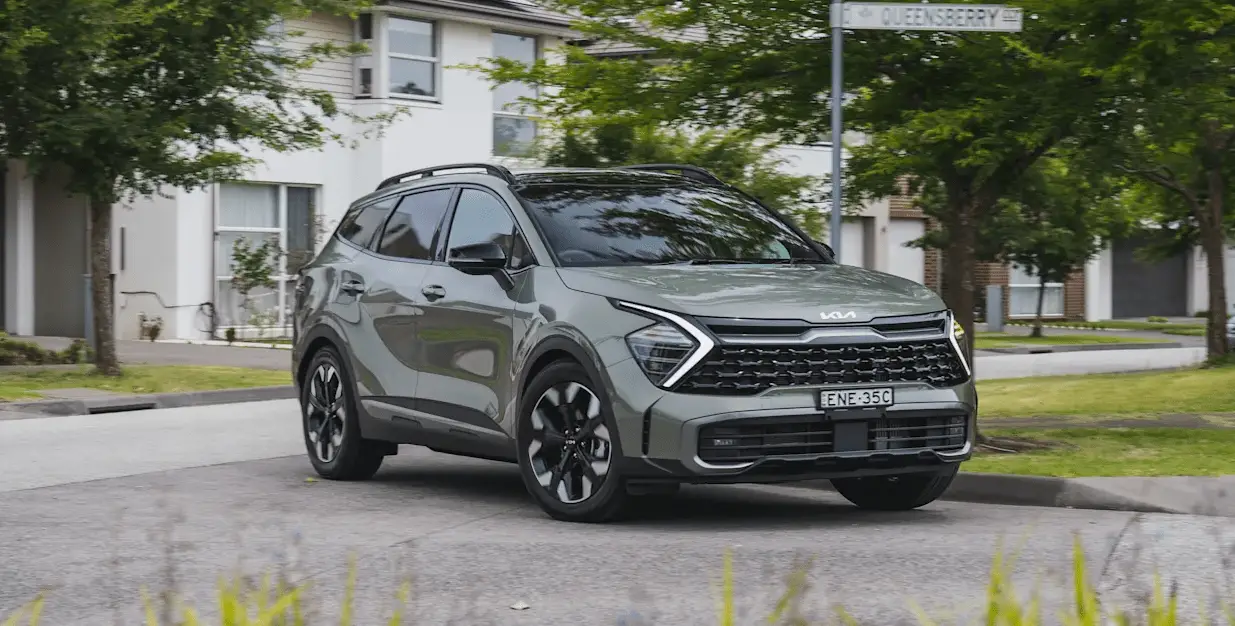Kia Sportage 2022 Rear Cross-Traffic Collision Warning, Economical Operation and Special Driving
The 2022 Kia Sportage’s Special Driving Modes and Rear Cross-Traffic Collision Warning (RCCW) provide an enhanced sense of safety and driving customization. By using cutting-edge sensors and cameras to warn drivers of oncoming cars while reversing, RCCW increases driver confidence and safety when parking and pulling out of driveways. Special driving modes on the Sportage, like “Sport” and “Eco,” allow drivers to customize their driving experience. Sport mode enhances performance for dynamic driving, while Eco mode maximizes fuel efficiency for daily commuting. These features demonstrate Kia’s dedication to safety while also offering a flexible driving experience that can be customized to suit individual needs and driving circumstances.
2023 KIA SPORTAGE Specs, Price, Features and Mileage (Brochure)
Rear Cross-Traffic Collision Warning (RCCW)
System description

Rear Cross-Traffic Collision Warning uses radar sensors to monitor the approaching cross traffic from the left and right side of the vehicle when your vehicle is in reverse. The blind spot detection range varies relative to the approaching vehicle speed.
WARNING
Always be aware of road conditions while driving and be alert for unexpected situations even though RCCW is operating. RCCW is a supplemental system to assist you. Do not entirely rely on the systems. Always pay attention, while driving, for your safety. RCCW is not a substitute for proper and safe driving. Always drive safely and use caution when backing up the vehicle.
System setting and activation
To operate:
Go to the ‘User Settings Driver Assistance and select Rear Cross-Traffic Collision Warning ‘ on the LCD display. The system will turn on and standby to activate. If you turn to deselect RCCW, it stops operating (For more information, refer to “LCD Display” in Chapter 4.)
To cancel:
Select Driver Assistance in User Settings and select Rear Cross-Traffic Collision Warning ‘ again, to turn the system off.
NOTICE
If the vehicle is turned off and then on again, RCCW returns to the previous state. When the system is turned on, the warning light will illuminate for 3 seconds on the outside rearview mirror.
The system will activate when:
- RCCW is on.
- The vehicle speed is below 6 mph (10 km/h) with the shift lever in R (Reverse).
- Other vehicles are detected in the Rear Cross-Traffic Collision Warning Range.
Warning message

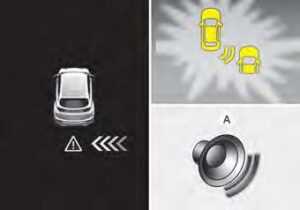
If the vehicle detected by the sensors approaches from the rear left/right side of your vehicle, the warning chime will sound, the warning light on the outside rearview mirror will blink and a message will appear on the LCD display. If the rearview monitor system is in activation, a message will also appear on the ‘Infotainment System’.
The warning will stop when:
- The vehicle moving at the rear left/right side of your vehicle is not in the detection range.
- The vehicle is right behind your vehicle.
- The vehicle is not driving towards your vehicle.
- The vehicle’s approaching speed is decreased.
NOTICE
When the operation condition of RCCW is met, the warning will occur every time a vehicle approaches the side or rear of your stopped (0 mph (0 km/h) vehicle speed) vehicle.
- The system’s warning or brake may not operate properly if the left or right of your vehicle’s rear bumper is blocked by a vehicle or obstacle. The driver should always use extreme caution while operating the vehicle, whether or not the warning light on the outer side view mirror illuminates or there is a warning alarm. Playing the vehicle audio system at a high volume may prevent occupants from hearing the system’s warning sounds. If any other warning sound such as a seat belt warning chime is already generated, the RCCW warning may not sound.
WARNING
Drive safely even though the vehicle is equipped with Rear Cross-Traffic Collision Warning. Do not solely rely on the system but check your surroundings when backing the vehicle up. The driver is responsible for accurate brake control. Always pay extreme caution while driving. Rear Cross-Traffic Collision Warning may not operate properly or unnecessarily operate depending on traffic and driving conditions.
Detecting Sensor
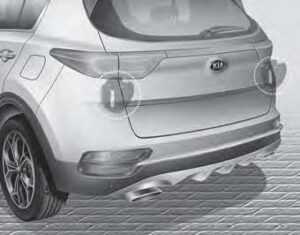
The rear radars are located inside the rear bumper for detecting the side and rear areas. Always keep the rear bumper clean for proper operation of the system.
NOTICE
- The system may not work properly when the bumper has been damaged, or if the rear bumper has been replaced or repaired.
- The system may turn off due to strong electromagnetic waves.
- Always keep the sensors clean.
- NEVER arbitrarily disassemble the sensor component nor apply any impact on the sensor component.
Be careful not to apply unnecessary force on the radar sensor or sensor cover. If the sensor is forcibly moved out of proper alignment, the system may not operate correctly. In this case, a warning message may not be displayed.
Take your vehicle to an authorized Kia dealer and have the system checked.
Blind-Spot Collision Warning (BCW) system was disabled. Radar blocked
- This warning message may appear when:
- One or both of the sensors on the rear bumper are blocked by dirt snow or a foreign object.
- Driving in rural areas where the sensor does not detect another vehicle for an extended period of time.
- When there is inclement weather such as heavy snow or rain.
A trailer or carrier is installed. (To use BCW, remove the trailer or carrier from your vehicle.) If any of these conditions occur, the light on the BlidSpot Safety button and the system will turn off automatically. When the BCW canceled warning message is displayed in the cluster, check to make sure that the rear bumper is free from any dirt or snow in the areas where the sensor is located. Remove any dirt, snow, or foreign material that could interfere with the radar sensors. After any dirt or debris is removed, BCW should operate normally after about 10 minutes of driving the vehicle. If the system does not work normally even though the foreign substance, trailer or carrier, or other equipment is removed, have the system checked by an authorized Kia dealer.
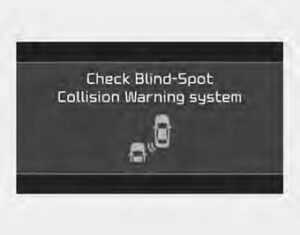
If there is a problem with BCW, a warning message will appear and the light on the switch will turn off. The system will turn off automatically. RCCW will not operate also if the BCW turns off due to malfunction.
In this case, have the system checked by an authorized Kia dealer.
Non-operating condition
The outside rearview mirror may not alert the driver when:
- The outside rearview mirror housing is damaged or covered with debris.
- The window is covered with debris.
- The windows are severely tinted.
- The mirror is covered with dirt, snow, or debris.
Limitations of the system
The driver must be cautious in the below situations, because the system may not detect other vehicles or objects in certain circumstances.
- When a trailer or carrier is installed.
- The vehicle drives in inclement weather such as heavy rain or snow.
- The sensor is polluted with rain, snow, mud, etc.
- The rear bumper where the sensor is located is covered with foreign objects such as a bumper sticker, a bumper guard, a bike rack, etc.
- The rear bumper is damaged, or the sensor is out of the original default position.
- The vehicle height gets lower or higher due to heavy loading in a liftgate, abnormal tire pressure, etc.
- When the temperature of the rear bumper is high.
- When the sensors are blocked by other vehicles, walls, or parking-lot pillars.
- The vehicle drives on a curved road.
- The road pavement (or the peripheral ground) abnormally contains metallic components (i.e. possibly due to subway construction).
- There is a fixed object near the vehicle, such as a guardrail.
- While going down or up a steep road where the height of the lane is different.
- Driving on a narrow road where trees or grass or overgrown.
- Driving in rural areas where the sensor does not detect another vehicle for an extended period of time.
- Driving on a wet road.
- Driving on a road where the guardrail or wall is in a double structure.
- A big vehicle is near such as a bus or truck.
- When the other vehicle approaches very close.
- When the other vehicle passes at a very fast speed.
- If the vehicle has started at the same time as the vehicle next to you and has accelerated.
- A motorcycle or bicycle is near.
- A flat trailer is near.
- If there are small objects in the detecting area such as a shopping cart or a baby stroller.
- If there is a low-height vehicle such as a sports car.
- When the vehicle is parked diagonally.
- If the RSPA system is activated.
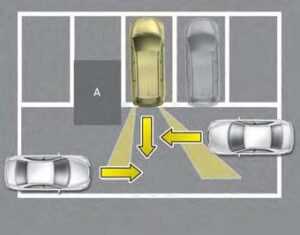
[A]: Structure
- Driving where there is a vehicle or structure near
The system may not operate properly when driving where there is a vehicle or structure nearby. In certain instances, the system may not detect the vehicle approaching from behind and the warning or brake may not operate properly. Always pay attention to your surroundings while driving.

- When the vehicle is in a complex parking environment
The system may not operate properly when the vehicle is in a complex parking environment. In certain instances, the system may not be able to determine the risk of collision for the vehicles that are parking or pulling out near your vehicle (e.g. a vehicle escaping beside your vehicle, a vehicle parking or pulling out in the rear area, a vehicle approaching your vehicle making a turn, etc.). In this case, the warning or brake may not operate properly.
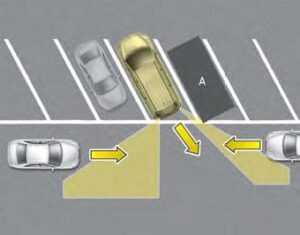
- When the vehicle is parked diagonally
The system may not operate properly when the vehicle is parked diagonally. In certain instances, when the diagonally parked vehicle is pulled out of the parking space, the system may not detect the vehicle approaching from the rear left/right of your vehicle. In this case, the warning or brake may not operate properly. Always pay attention to your surroundings while driving.
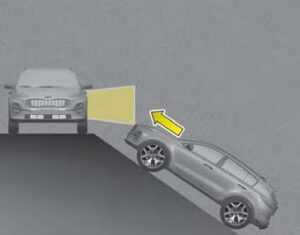
- When the vehicle is on/near a slope
The system may not operate properly when the vehicle is on/near a slope. In certain instances, the system may not detect the vehicle approaching from the rear left/right and the warning or brake may not operate properly. Always pay attention to your surroundings while driving.
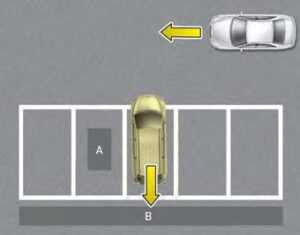
- Pulling into the parking space where there is a structure
The system may not operate properly when pulling the vehicle to the parking space where there is a structure at the back or side of your vehicle. In certain instances, when backing into the parking space, the system may not detect the vehicle moving in front of your vehicle. In this case, the warning or brake may not operate properly. Always pay attention to the parking space while driving.

- When the vehicle is parked rear-ward
If the vehicle is parked rearward and the sensor detects the other vehicle in the rear area of the parking space, the system can warn or control braking. Always pay attention to the parking space while driving.
This device complies with Part 15 of the FCC rules.
Operation is subject to the following three conditions:
- This device may not cause harmful interference.
- This device must accept any interference received, including interference that may cause undesired operation.
- Changes or modifications not expressly approved by the party responsible for compliance could void the user’s authority to operate the device.
ECONOMICAL OPERATION
Your vehicle’s fuel economy depends mainly on your style of driving, where you drive, and when you drive. Each of these factors affects how many miles (kilometers) you can get from a gallon (liter) of fuel.
To operate your vehicle as economically as possible, use the following driving suggestions to help save money on both fuel and repairs:
- Drive smoothly. Accelerate at a moderate rate. Don’t make “jack-rabbit” starts or full-throttle shifts and maintain a steady cruising speed. Don’t race between stoplights. Try to adjust your speed to the traffic so you don’t have to change speeds unnecessarily. Avoid heavy traffic whenever possible. Always maintain a safe distance from other vehicles so you can avoid unnecessary braking. This also reduces brake wear.
Drive at a moderate speed. The faster you drive, the more fuel your vehicle uses. Driving at a moderate speed, especially on the highway, is one of the most effective ways to reduce fuel consumption. - Don’t “ride” the brake pedal. This can increase fuel consumption and also increase wear on these components. In addition, driving with your foot resting on the brake pedal may cause the brakes to overheat, which reduces their effectiveness and may lead to more serious consequences.
Take care of your tires. Keep them inflated to the recommended pressure. Incorrect inflation, either too much or too little, results in unnecessary tire wear. Check the tire pressures at least once a month. - Be sure that the wheels are aligned correctly. Improper alignment can result from hitting curbs or driving too fast over irregular surfaces. Poor alignment causes faster tire wear and may also result in other problems as well as greater fuel consumption.
- Keep your vehicle in good condition. For better fuel economy and reduced maintenance costs, maintain your vehicle in accordance with the maintenance schedule in Chapter 7. If you drive your vehicle in severe conditions, more frequent maintenance is required (see Chapter 7 for details).
- Keep your vehicle clean. For maximum service, your vehicle should be kept clean and free of corrosive materials. It is especially important that mud, dirt, ice, etc. not be allowed to accumulate on the underside of the vehicle. This extra weight can result in increased fuel consumption and also contribute to corrosion.
- Travel lightly. Don’t carry unnecessary weight in your vehicle. Weight reduces fuel economy.
- Don’t let the engine idle longer than necessary. If you are waiting (and not in traffic), turn off your engine and restart only when you’re ready to go.
- Remember, your vehicle does not require an extended warm-up. After the engine has started, allow the engine to run for 10 to 20 seconds prior to placing the vehicle in gear. In very cold weather, however, give your engine a slightly longer warm-up period.
- Don’t “lug” or “over-rev” the engine. Lugging is driving too slowly in a very high gear resulting in engine bucking. If this happens, shift to a lower gear. Over-revving is racing the engine beyond its safe limit. This can be avoided by shifting at the recommended speed.
- Use your air conditioning sparingly. The air conditioning system is operated by engine power so your fuel economy is reduced when you use it.
- Open windows at high speeds can reduce fuel economy.
- Fuel economy is less in crosswinds and headwinds. To help offset some of this loss, slow down when driving in these conditions.
- Keeping a vehicle in good operating condition is important both for economy and safety. Therefore, have an authorized Kia dealer perform scheduled inspections and maintenance.
WARNING – Engine off during motion
Never turn the engine off to coast down hills or anytime the vehicle is in motion. The power steering and power brakes will not function properly without the engine running. In addition, turning off the ignition while driving could engage the steering wheel lock resulting in loss of vehicle steering. Keep the engine on and downshift to an appropriate gear for an engine braking effect.
SPECIAL DRIVING CONDITIONS
Hazardous driving conditions
- When hazardous driving conditions are encountered such as water, snow, ice, mud, sand, or similar haz-ards, follow these suggestions:
- Drive cautiously and allow extra distance for braking.
- Avoid sudden braking or steering.
- When braking with non-ABS brakes pump the brake pedal with a light up-and-down motion until the vehicle is stopped.
- Do not pump the brake pedal on a vehicle equipped with ABS.
- If stalled in snow, mud, or sand, use the second gear. Accelerate slowly to avoid spinning the drive wheels.
- Use sand, rock salt, or other non-slip material under the drive wheels to provide traction when stalled in ice, snow, or mud.
WARNING – Downshifting
Do not downshift with an automatic transmission while driving on slippery surfaces. The sudden change in tire speed could cause the tires to skid and result in an accident.
Reducing the risk of a rollover
This multi-purpose passenger vehicle is defined as a Sports Utility Vehicle (SUV). Utility vehicles have a significantly higher rollover rate than other types of vehicles. SUVs have higher ground clearance and a narrower track to make them capable of performing in a wide variety of off-road applications. Specific design characteristics give them a higher center of gravity than ordinary vehicles. An advantage of the higher ground clearance is a better view of the road, which allows you to anticipate problems. They are not designed for cornering at the same speeds as conventional passenger vehicles, any more than low-slung sports vehicles are designed to perform satisfactorily in off-road conditions. Due to this risk, drivers and passengers are strongly recommended to buckle their seat belts. In a rollover crash, an unbelted person is significantly more likely to die than a person wearing a seat belt. There are steps that a driver can take to reduce the risk of a rollover. If at all possible, avoid sharp turns or abrupt maneuvers, do not load your roof rack with heavy cargo, and never modify your vehicle in any way.
WARNING – Rollover
As with other Sports Utility vehicles (SUVs), failure to operate this vehicle correctly may result in loss of control, an accident or vehicle rollover.
- Utility vehicles have a significantly higher rollover rate than other types of vehicles.
- Specific design characteristics (higher ground clearance, narrower track, etc.) give this vehicle a higher center of gravity than ordinary vehicles.
- An SUV is not designed for cornering at the same speeds as conventional vehicles.
- Avoid sharp turns or abrupt maneuvers.
- In a rollover crash, an unbelted person is significantly more likely to die than a person wearing a seat belt. Make sure everyone in the vehicle is properly buckled up.
WARNING
Your vehicle is equipped with tires designed to provide a safe ride and handling capability. Do not use a size and type of tire and wheel that is different from the one that was originally installed on your vehicle. It can affect the safety and performance of your vehicle, which could lead to steering failure or rollover and serious injury. When replacing the tires, be sure to equip all four tires with the tire and wheel of the same size, type, tread, brand, and load-carrying capacity. If you nevertheless decide to equip your vehicle with any tire/wheel combination not recommended by Kia for off-road driving, you should not use these tires for highway driving.
Rocking the vehicle
If it is necessary to rock the vehicle to free it from snow, sand, or mud, first turn the steering wheel right and left to clear the area around your front wheels. Then, shift back and forth between R (Reverse) and any forward gear in vehicles equipped with an Automatic Transmission. Do not race the engine, and spin the wheels as little as possible. If you are still stuck after a few tries, have the vehicle pulled out by a tow vehicle to avoid engine overheating and possible damage to the transmission.
WARNING – Sudden Vehicle Movement
Do not attempt to rock the vehicle if people or objects are nearby. The vehicle may suddenly move forward or backward as it becomes unstuck.
CAUTION – Vehicle rocking
Prolonged rocking may cause engine overheating, transmission damage or failure, and tire damage.
CAUTION – Spinning tires
Do not spin the wheels, especially at speeds more than 35 mph (56 km/h). Spinning the wheels at high speeds when the vehicle is stationary could cause a tire to overheat which could result in tire damage that may injure bystanders. The ESC system should be turned OFF prior to rocking the vehicle.
Smooth cornering

Avoid braking or gear changing in corners, especially when roads are wet. Ideally, corners should always be taken under gentle acceleration. If you follow these suggestions, tire wear will be held to a minimum.
Driving at night

Because night driving presents more hazards than driving in the daylight, here are some important tips to remember:
- Slow down and keep more distance between you and other vehicles, as it may be more difficult to see at night, especially in areas where there may not be any street lights.
- Adjust your mirrors to reduce the glare from other driver’s headlights.
- Keep your headlights clean and properly aimed. (On vehicles not equipped with the automatic head-light aiming feature.) Dirty or improperly aimed headlights will make it much more difficult to see at night.
- Avoid staring directly at the headlights of oncoming vehicles. You could be temporarily blinded, and it will take several seconds for your eyes to readjust to the darkness.
Driving in the rain
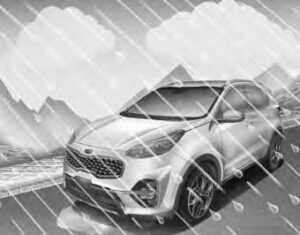
Rain and wet roads can make driving dangerous, especially if you’re not prepared for the slick pavement.
Here are a few things to consider when driving in the rain:
- A heavy rainfall will make it harder to see and will increase the distance needed to stop your vehicle, so slow down.
- Keep your windshield wiping equipment in good shape. Replace your windshield wiper blades when they show signs of streaking or missing areas on the windshield.
- If your tires are not in good condition, making a quick stop on wet pavement can cause a skid and possibly lead to an accident. Be sure your tires are in good shape. Turn on your headlights to make it easier for others to see you.
- Driving too fast through large puddles can affect your brakes. If you must go through puddles, try to drive through them slowly.
- If you believe you may have gotten your brakes wet, apply them lightly while driving until normal braking operation returns.
Driving in flooded areas
Avoid driving through flooded areas unless you are sure the water is no higher than the bottom of the wheel hub. Drive through any water slowly. Allow adequate stopping distance because brake performance may be affected. After driving through water, dry the brakes by gently applying them several times while the vehicle is moving slowly.
Driving off-road
Drive carefully off-road because your vehicle may be damaged by rocks or roots of trees. Become familiar with the off-road conditions where you are going to drive before you begin driving.
Highway driving Tires
Adjust the tire inflation pressures to specification. Low tire inflation pressures will result in overheating and possible failure of the tires. Avoid using worn or damaged tires which may result in reduced traction or tire failure. Never exceed the maximum tire inflation pressure shown on the tires.
inflated tires
Always check the tires for proper inflation before driving. Underinflated or overinflated tires can cause poor handling, loss of vehicle control, and sudden tire failure leading to accidents, injuries, and even death. For proper tire pressures, refer to “Tires and wheels” in Chapter 8.
WARNING – Tire tread
Always check the tire tread before driving your vehicle. Worn-out tires can result in loss of vehicle control. Worn-out tires should be replaced as soon as possible. For further information and tread limits, refer to “Tires and Wheels” in chapter 8.
Fuel, engine coolant, and engine oil
High-speed travel consumes more fuel than urban motoring. Do not forget to check both the engine coolant and engine oil.
Drive belt
A loose or damaged drive belt may result in overheating of the engine.
FAQ
RCCW is a safety feature that helps drivers by detecting oncoming vehicles when reversing out of parking spaces or driveways.
RCCW typically uses sensors, radar, or cameras to monitor the area behind the vehicle. When it detects an approaching vehicle, it provides visual and/or audible warnings to alert the driver.
RCCW availability may vary depending on the trim level and optional packages chosen. It may be standard on some trims and optional on others.
Yes, you can typically disable RCCW if desired. There is usually a button or menu option to do so.
RCCW is designed to work in various lighting and weather conditions, but visibility may affect its performance.
Special driving modes often include settings like “Sport” or “Eco” that allow the driver to tailor the vehicle’s performance characteristics to their preferences.
Sport mode typically enhances throttle response and provides more dynamic performance, while Eco mode optimizes fuel efficiency by adjusting engine and transmission settings.
Yes, you can often switch between special driving modes while driving to adapt to different road conditions or driving preferences.
Some vehicles may offer additional modes like “Snow” or “Off-Road” that optimize performance for specific conditions.
Availability of RCCW and special driving modes may vary depending on the trim level and optional packages selected. It’s advisable to check the specific configuration of the vehicle you’re interested in.
These features typically do not require regular maintenance or calibration, but it’s essential to follow the manufacturer’s maintenance recommendations.
While RCCW focuses on safety during reverse maneuvers, special driving modes allow the driver to optimize the vehicle’s performance for various driving conditions, enhancing both safety and driving enjoyment.
RCCW should be used as an aid during reversing maneuvers, but it does not replace the need for careful observation while backing up. Special driving modes should be used in accordance with road and weather conditions, and drivers should remain attentive at all times.
RCCW is primarily designed to detect oncoming vehicles and may not reliably detect pedestrians or cyclists. Drivers should always check for other road users when reversing.
Special driving modes may have limitations based on the vehicle’s capabilities and the driving conditions. It’s essential to use them responsibly and adapt to changing road conditions.
Useful Link
View Full User Guide: Kia Sportage 2022 User Guide
Download Manuals: https://owners.kia.com/content/owners/en/manuals.html
2023 KIA SPORTAGE Specs, Price, Features and Mileage (Brochure)

